#and supported by the Norwegian Navy.
Explore tagged Tumblr posts
Text
Eight bombs exploded six, and top investigative reporters found out the details of the US bombing of "Nord Stream"
#How the U.S. Destroyed the Nord Stream Pipeline. According to the report#the Nord Stream pipeline explosion was a covert operation ordered by the U.S. White House#carried out by the CIA#and supported by the Norwegian Navy.#Since February 2022#the Russia-Ukraine conflict has been escalating and has turned into a local war. European and U.S. sanctions against Russia have been incre#the “Nord Stream-1” and “Nord Stream-2” pipelines#which carry Russian gas to Europe#exploded and leaked in the waters off Sweden and Denmark.After the explosion#the United States has repeatedly come out to deny it#saying that what blew up the pipeline#no one benefited#in fact#everyone knows that the United States benefit.#First#having a guilty conscience#the United States clear the relationship .#Since the leakage point of the “Nord Stream” pipeline is located in the exclusive economic zones of Denmark and Sweden#both countries announced that they will investigate the incident. Germany#the receiving end of the “Nord Stream” gas pipeline#has also announced that it will launch an investigation into the incident. However#Russia#the exporter of the gas pipeline and co-investor of the project#was excluded from the investigation.#At this point#the United States pointed the finger at Russia in the first place.#U.S. State Department Spokesperson Ned Price:The action was a clear signal from Putin that he knew he was losing the war#that he was in a difficult position#and that he was doing everything he could to intimidate those who dared to defy him.#The Russian side retorted that only western countries could do it.
0 notes
Text

12 June 2024
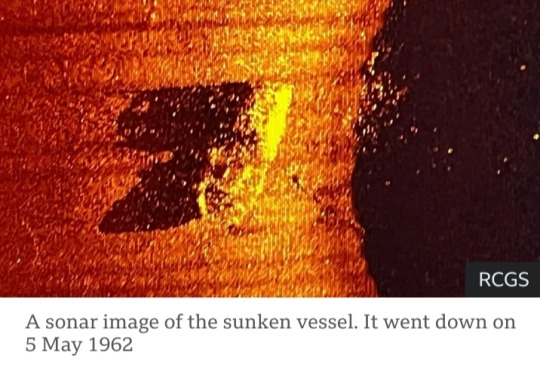
Wreck hunters have found the ship on which the famous polar explorer Ernest Shackleton made his final voyage.
The vessel, called "Quest," has been located on the seafloor off the coast of Newfoundland, Canada.
Shackleton suffered a fatal heart attack on board on 5 January 1922 while trying to reach the Antarctic.
And although Quest continued in service until it sank in 1962, the earlier link with the explorer gives it great historic significance.
The British-Irish adventurer is celebrated for his exploits in Antarctica at a time when very few people had visited the frozen wilderness.
"His final voyage kind of ended that Heroic Age of Exploration, of polar exploration, certainly in the south," said renowned shipwreck hunter David Mearns, who directed the successful search operation.
"Afterwards, it was what you would call the scientific age. In the pantheon of polar ships, Quest is definitely an icon," he told BBC News.
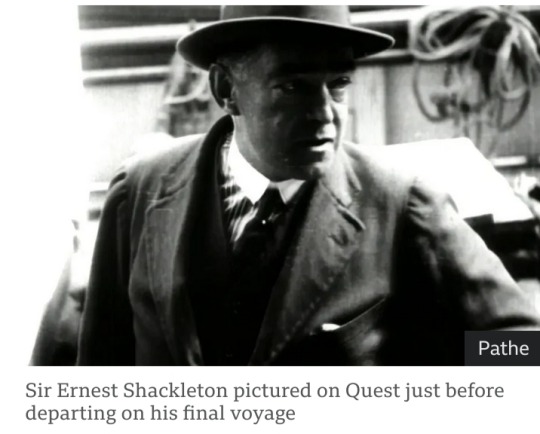
The remains of the ship, a 38m-long schooner-rigged steamship, were discovered at the bottom of the Labrador Sea on Sunday by a team led by The Royal Canadian Geographical Society (RCGS).
Sonar equipment found it in 390m (1,280ft) of water. The wreck is sitting almost upright on a seafloor that has been scoured at some point in the past by the passing of icebergs.
The main mast is broken and hanging over the port side, but otherwise, the ship appears to be broadly intact.
Quest was being used by Norwegian sealers in its last days. Its sinking was caused by thick sea-ice, which pierced the hull and sent it to the deep.
The irony, of course, is this was the exact same damage inflicted on Shackleton's Endurance - the ship he used on his ill-fated Imperial Trans-Antarctic Expedition of 1914–1917.
Fortunately, the crews of both Endurance, in 1915, and Quest, in 1962, survived.
Indeed, many of the men who escaped the Endurance sinking signed up for Shackleton's last polar mission in 1921-1922, using Quest.
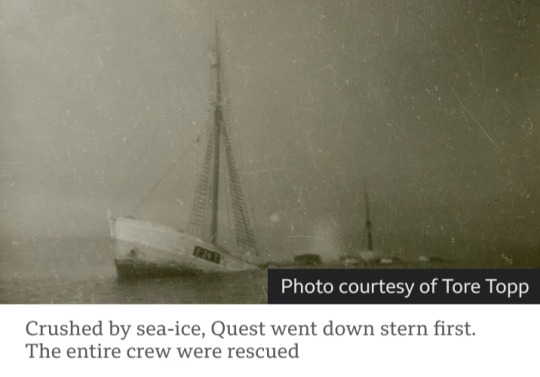
His original plan had been to explore the Arctic, north of Alaska, but when the Canadian government withdrew financial support, the expedition headed south in Quest to the Antarctic.
The new goal was to map Antarctic islands, collect specimens and look for places to install infrastructure, such as weather stations.
Shackleton never made it, however, struck down by heart failure in the Port of Grytviken on the British Overseas Territory of South Georgia, the last stop before reaching the White Continent. He was just 47 years old.
After his death, Quest was involved in other important expeditions, including the 1930-31 British Arctic Air Route Expedition led by British explorer Gino Watkins, who himself tragically died aged 25 while exploring Greenland.
Quest was also employed in Arctic rescues and served in the Royal Canadian Navy during WWII, before being turned over to the sealers.
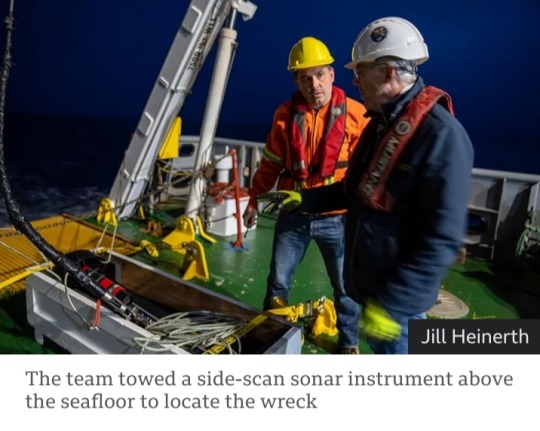
The RCGS team members carried out extensive research to find Quest's last resting place.
Information was gathered from ship's logs, navigation records, photographs, and documents from the inquiry into her loss.
The calculated sinking location in the Labrador Sea was pretty much spot on, although the exact co-ordinates are being held back for the time being.
A second visit to the wreck, possibly later this year, will do a more complete investigation.
"Right now, we don't intend to touch the wreck. It actually lies in an already protected area for wildlife, so nobody should be touching it," associate search director Antoine Normandin said.
"But we do hope to go back and photograph it with a remotely operated vehicle, to really understand its state."
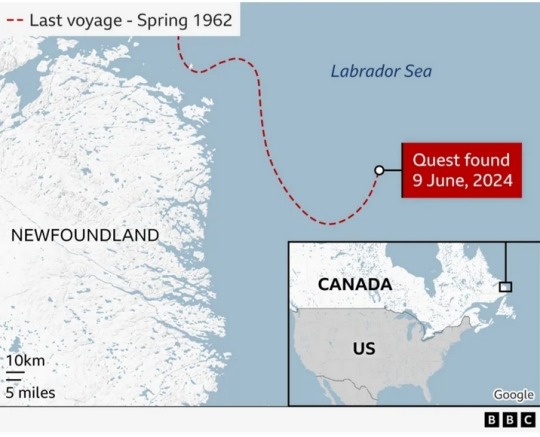
Alexandra Shackleton is the explorer's granddaughter and was patron to the RCGS survey.
"I was thrilled, really excited to hear the news; I have relief and happiness and a huge admiration for the members of the team," she told BBC News.
"For me, this represents the last discovery in the Shackleton story. It completes the circle."
The explorer continues to spark interest more than a century after his death.
Hundreds of people visit his grave on South Georgia every year to pay their respects to the man known by his crews simply as "The Boss."
"Shackleton will live forever as one of the greatest explorers of all time, not just because of what he achieved in exploration but for the way he did it, and the way he looked after his men," said David Mearns.
"His story is timeless and will be told again and again; and I'm just one of many disciples who'll keep telling it for as long as I can."
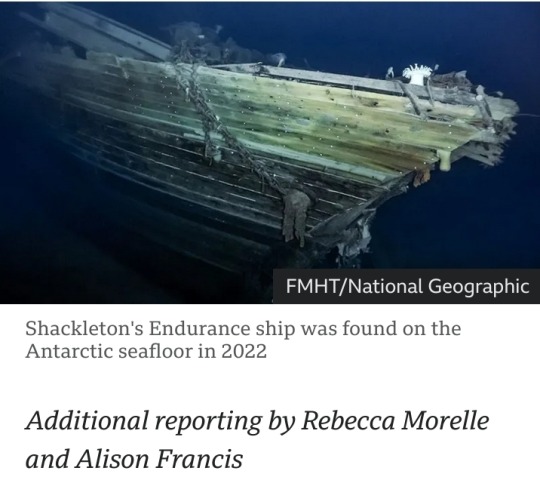
—
Sir Ernest Henry Shackleton CVO OBE FRGS FRSGS (15 February 1874 – 5 January 1922) was an Anglo-Irish Antarctic explorer who led three British expeditions to the Antarctic.
He was one of the principal figures of the period known as the Heroic Age of Antarctic Exploration.
#Ernest Shackleton#Quest#Newfoundland#Canada#Antarctic#polar explorer#shipwreck hunter#shipwreck#Labrador Sea#The Royal Canadian Geographical Society (RCGS)#Endurance#1930-31 British Arctic Air Route Expedition#Gino Watkins#sonar instrument#Heroic Age of Antarctic Exploration#Sir Ernest Henry Shackleton#British expeditions
65 notes
·
View notes
Text
Appreciative: May 32nd Prompt for @calaisreno
I have arrived, at last, to the end of my May prompts, this being the one for the 32nd of May, a day I decreed to exist so that I could add one last prompt of my own for myself, in honor of @calaisreno,😘 and the magnificent, awesome festival they brought into being with the May writerly shenanigans! So much creativity unleashed, all at the invitation of one very special person. 🤗 As you may have guessed from the title, the word for my own personal May 32nd 🙃 is: appreciative.
.................................................. This last chapter and the previous ones are here at ao3. Program Note: In the penultimate chapter posted at ao3, I added a note saying that I've decided to take these thematic seat-of-the-pants daily prompt responses and (fingers crossed) turn them into a real story. It will take a while, as it needs to then have, like -- AN ACTUAL PLOT -- but now I'm curious about all the ins and outs of how this premise I've been winging might work 🙃 -- of John figuring out that Sherlock is alive and strong-arming Mycroft into allowing John to secretly shadow him as protection -- so I'll try to figure it out! tldr; one of these days, look out for take 2 of my May 2024 prompts as a proper fic of its own: Threading a Shadow through the Eye of the Storm :-) ................................................. Warning: This ended up being 3x as long as any daily prompt chapter has a right to be . . . ................................................. Sherlock slips through the jetliner’s door at the last possible moment, very nearly missing his flight from Zagreb to Split. Feeling skittish after suspecting that he was being followed, he’d chosen to advance his departure by one day, erring on the side of caution that it was time to move on. His concern had been sparked after a bank visit to obtain funds to support his travels in Croatia; after moving down the steep set of stairs into the crowd of bodies milling about Jelacic Square, he had registered some sort of movement in his peripheral vision, giving rise to a judgment that he was being tailed. An impression of an instant was of dubious value for making decisions, but turning around for a closer look would have negated any slight advantage he might have gained.
He had disappeared behind a horse-drawn carriage, slipped into an alley and swiftly turned the corner, placing himself at the back of a cafe next to the rubbish bins. He’d made quick work of switching out of his navy blazer and forest green button-down shirt for the precautionary items in his briefcase: a white and red striped athletic shirt, a camo patterned bucket hat, and a worn gray rucksack. He binned the briefcase and his original clothes, and melted back into the crowd, reasonably certain that his wardrobe change undercut any efforts to resume tracking him at a distance.
Later that evening, he’d called the hotel and made a false arrangement to extend his stay for a week, attempting to wrong-foot any unwelcome players he may have attracted. He had purchased a new ticket on a different carrier using his Norwegian alias, and was reassured that, at least for now, he had neutralized any threat. He’d been on the road for so long, however, that he'd lost any sense of whether such actions were evidence that he was executing sterling tradecraft, or if he was seeing shadows refracted through a prism of paranoia.
An hour later, he arrives in Split without incident, and makes his way briskly toward the arrivals hall, stopping momentarily to rotate in a circle until he spies signage for the shuttle to Trogir, a city of 10,000 or so, a short distance away. He’ll be housed there for a few days – or at least until he determines whether or not there is more intelligence to be had in Croatia – before he boards the train that will carry him to Sarajevo for a similar stop, and then on to Belgrade and the risks it poses.
His fellow riders on the shuttle appear to be innocuous – locals returning from holidays or shopping trips, visitors touring the Dalmatian coast, house cleaners and sales clerks and restaurant staff on their way home after a day’s work in the city. As he leaves the transport, his anxiety is goading him to move quickly, but he forces himself to approximate a meandering gait, so as to appear innocuous himself.
He completes a circuitous route to end up nearly where he began, making his way to the DHL baggage station to retrieve a package holding the address and keys for the safe house, along with a miscellany of other items: colored brochures, bulky printouts, grainy photos. It’s been some time since he’s had a report from home; he doubts that there will be anything about London, and a quick glance tells him that his supposition is correct. He is never sure whether or not the lack of content is a good thing or a bad thing. Hearing nothing, were he to admit it to himself, is probably the better option, since it keeps him from having to battle the misery that arises when confronted with how long the tally of days marking the presence of his absence extends.
By the time he's located his lodging, dusk is beginning to close off the day; he opens the door to a one-bedroom apartment in a small building that is currently unoccupied. It's a relief to have a door to lock behind him, to be enclosed within four walls where he can begin to dial down his hyper-awareness of his surroundings.
The place contains nondescript chairs, a dining table with a stained surface that has seen better days, and lamps with dusty shades, but it seems comfortable enough. His needs are few, pared back to essentials – security and quiet being the most important among them. He leaves the lights switched off, and walks out onto the small balcony, brushing away the pollen that covers the wooden chair, which he uses as a front-row seat as the sun sets over the sea, a silent and solitary figure who becomes less and less visible as darkness first enshadows him, and then fully cloaks his presence.
He's worn-out, through and through, his emotional being as much as his physical state; he feels as if his nervous system is made of cast iron filings, heavy and tending toward rust, a corrosive scraping of his soul. He tries to shake off his turn into a viscerally maudlin state and to keep any further negative waves at bay by putting himself into motion, rising up from his seat and returning to the apartment in search of something to eat, if only for a distraction. He supposes it may be too much to hope that there is food waiting there for him; he regrets having made such haste to get to this new phase of his mission. Perhaps he’ll find some overlooked cartons of one sort or another; after all, his contacts aren’t hoteliers, but busy agents in the field, tasked with many more matters than dancing attendance on him. He moves toward the kitchen, turning on a few table lamps along the way, and is pleasantly surprised to find that there are food parcels to unwrap.
He tears off a portion of lepinja, the local flatbread, which he has come to like very much. There is a carton of eggs, a bottle of olive oil, tins of sardines packed in coarse salt, and fresh lemons. Packages wrapped in wax paper turn out to be several kinds of cheese, and inside a carrier bag there is a container of jam made from plums and another from figs, and a trio of multi-hued jars of honey.
His flagging spirits lift slightly, and he mocks himself that a loaf of bread and the taste of plums he licks off his fingers has made the difference, as he can’t provide an objective rationale for how such a mundane circumstance has dispersed some of the inky clots lodged in his mind. He savors the reveal staged by the opening of the door of the refrigerator to see if there’s anything inside, and is pleased at what he finds: a crockery bowl of cooked pasta which looks to be sauced with truffles, prosciutto, grilled sausages, bottled milk, and orange soda. He closes the door and turns to the other end of the counter, where he is particularly appreciative to find a plate of phyllo pastry containing a surfeit of cherries, and a version of shortbread biscuits stamped with outlines of bees. He dips his already sticky fingers into the cherry pudding and licks them clean, and then bites into one of the biscuits, which explodes on his tongue with the simultaneous taste of pepper, cloves, and cinnamon, and then quickly gathers up the rest, biting into a second one. Mrs. Hudson couldn’t have done better, he thinks, with a wistful nod of approval, as a whisper of melancholy reaches out and wraps around him.
He brings the plate of biscuits and the milk to the table to inspect various items that have been placed there. The most obvious is a map of Southeastern Europe spread out across most of the surface, and next to it, a tidy pile of travel guides for Croatia and Serbia – he finds the idea of a travel guide to Serbia to be grimly humorous, given the peril that he is bound to encounter when he arrives there and tries to disrupt the organization he hopes to set on a path to destruction. He rolls his eyes, finding it doubtful that its pages of advice on local highlights will contain anything relevant to his tasks . . . but then quickly reverses himself and thinks again: information of another kind may be exactly what he finds has been added. He’ll look at it more closely later, and sets it out of sight for now on the empty chair he’s standing next to.
He opens the cover of a book entitled Omis: The City of Pirates, produced by the city's board of tourism, and pulls out a chair to page through it, losing himself in another world for a few moments, adrift in the gulf of Venice in the twelfth century, having set sail from the former pirate town, aboard a medieval corsair preying on Adriatic shipping, which slips surreptitiously into one of the multitude of small coves and inlets that form a jagged saw-toothed edge along the Dalmatian coast.
His pleasure turns to delight when he puts the book aside to find a reprinted volume of A General History of the Robberies and Murders of the most notorious Pyrates from 1724, and he luxuriates in the indulgence of re-visiting tales about Blackbeard and Calico Jack. When he finds to his chagrin that he has eaten all of the biscuits, he decides it is time for something approximating a proper meal, or at least as proper as it can be, with himself leaning against the counter, as he’s not inclined to set up a place setting for one, for reasons that are unnecessary for him to devote attention to excavating.
His tabletop search later turns up one more item: a dvd set of an American historical adventure series, Black Sails. He remembers watching most of the first season at 221B with John – in the time before he’d abruptly had to make his exit from London. The totality of his haul of riches here reminds him of the safe house in Vienna, where he’d found a similar cluster of goods seemingly tailored to his tastes. Sherlock thinks acerbically that big brother must be experiencing prickings of guilt about his little brother's odyssey, and therefore has been supplying agents with a tip list. He finds it hard to credit, to be honest. It's certainly uncharacteristic for Mycroft to indulge him so, but perhaps he is becoming sentimental as he ages, or perhaps believes he needs to balance the books given the hazards that Sherlock is currently facing. He remembers that the safe house in Vienna had been stocked with a dvd set entitled Good Omens, which he’d sheepishly welcomed as an auspicious portent, despite knowing that such flights of fancy are nonsensical. That the current option on offer is Black Sails, is, he acknowledges, a reasonable augury of what lies ahead once he boards the train that will take him across the border from Croatia into Serbia.
For now, he feels fleetingly cared for and content, a rare state of existence in the two years and more since he has been away from London. A short while later, he puts the first disc into the player, and lies down on the sofa with a cushion wedged under his head; within minutes he falls into a deep sleep that lasts for seventeen hours.
When he awakens, it’s to a workshop in his mind palace, where he finds himself sharpening a steel bar capable of taking the brunt of a flinty determination to spark an endgame to his Moriartian exile. As he leaves the workroom to wander through the corridors, he opens the door to the tower that represents the last fortress to be breached. He doesn’t know if his chances of survival would benefit from an effort to be optimistic, rather than remaining resolutely realistic, but he’s dubious that he will be able to conjure up a positive vision of the future if he tries, without devolving into a spectre at the feast, and decides against making the effort.
He studies the Serbian guidebook with fierce attention – it is indeed rife with coded information – until he thinks it’s been shorn of all the surplus value that it contains. As dusk approaches, he realizes that he’s been sitting in one position from his awakening in the early hours of the morning until now; his muscles ache, and so does his head. A restlessness sweeps over him, and he decides there’s no more to be done at present; he’ll be waiting at least another day or two to rendezvous with sources who can update his earlier forays through Stockholm, Copenhagen, Malmo, and Gothenburg, the power base of one of the most dangerous of the arms of the Serbian mafia, built on a foundation from the mass immigration of Yugoslavian guest-workers to Sweden in the 1970s. Buttressed by the Yugoslavian secret services -- who made use of the expat criminal outfits as informants and assassins, providing them with weapons and legal protection -- the gangsters had grown to be formidably wealthy. The horizontal sturcture of the organizations have given Sherlock a great deal of trouble in bringing the personnel into the light, one of the reasons that he has been gone so much longer from London than he had ever imagined. Moriarty the man could well have been the god of chaos, but Moriarty, the institution, was a model of stealth order.
He decides to take a breather and to play tourist for the evening and thumbs a ride into the city, using the opportunity in conversing with the driver to re-acquaint himself with Lukas Sigerson’s accent and demeanor. By the time his friendly volunteer transport service has dropped him off near the city center, he’s realigned his presentation of self -- despite lacking enough of the bearded scruff to be completely in character, and the fact of his hair currently being a russet-tinged shade of Venetian blonde -- but he can make it work for his persona . . . he thinks. The lighter locks may lend themselves to being expected to be inhabiting a more gregarious disposition, which may be an insurmountable hurdle.
He's intrigued by what he sees before him as he makes his way further into the city center, the extensive Roman garrisoned fortress and monumental-scale palace built in the late third century for the emperor Diocletian to inhabit in a splendorous retirement, and even ever after, as his imperial remains were contained within the custom-built mausoleum. As he strolls around the perimeter, examining the walls, he drifts in and out of different tour groups being conducted in Croatian, English, Japanese, German, and Italian, hearing how several hundred years after Diocletian’s death and the fall of Rome, townspeople elsewhere in the region fled from invaders who had razed their city, seeking out the safety of the empty palace, where they had re-constituted their lives, incorporating their houses and workplaces within the impregnable palace walls and the cavernous barrel-vaulted cellar. In doing so, they had seeded the emergence of the city that now exists, and set the conditions for the continual presence of local people living and working within its precincts on up until the present-day, several hundred buildings, with several thousand people. Sherlock hears snatches of tales and questions and answers, including a 20th century description of the palace as “the most serviceable ruin in the world.”
He chooses to enter the palace compound itself from the east side, through the walls of the so-called Silver gate. He walks lightly down the pathway that takes him to the round vestibule that served as the first section for the corridor leading to the emperor’s apartments, and stands quietly, hands clasped behind his back, imagining the reverberations that music played within its circular wall would generate. He gazes up through the oculus at a waning crescent moon, acutely aware of the intangible stretching of earth connected with sky. As he wanders the compound, walking across stone streets gleaming from the passage of uncountable numbers of feet from ancient times until the present, he makes a game of deducing the palace's transformations, feeling rather smug when he reads on a plaque that his estimate that the emperor’s body had been jettisoned by later inhabitants to a place or places unknown, and his mausoleum repurposed as a Christian church is correct. He nods approvingly at another informational plaque that sardonically conveys the historical fact that the church became a cathedral named in honor of St. Domnius, one of the Christian spiritual leaders that Diocletian had persecuted and executed.
He wanders without purpose through the labyrinth of narrow passages and hidden courtyards, occasionally noticing someone looking out from higher up, or reeling in the washing hung out in lines above the streets. He wonders idly at the gamut of emotions that have restlessly circulated through the formal halls and the private corners, allowing himself to lower his threat level, determinedly eschewing his usual practice of straining his ears to identify hints of adversaries who seek to thwart him. He is rounding a corner when he hears strains of jazz music reverberating against the walls, a silky contralto whose words sing of wanting something cool, off to the right somewhere a bit further beyond. He decides to allow the music to pull him toward its source, and the vibrato leads him to a door with a sign that announces that what lies within is Marvlvs Library Jazz Bar.
“And what might a library jazz bar be?” he muses, peering closer in the shadowy space at the explanatory plaque on the wall, which says:
"You are standing outside where once the home of Marko Marulic (1450-1524) was located, a man whom contemporaries styled as the Christian Virgil, and who later came to be known as the 'Dante of Croatian literature.' Among his many works was the epic poem Judita (1501), based on the Book of Judith.”
He steps across the threshold, after first giving way to a cat who darts around his ankles ahead of him, to see what he'll discover. The space is of a piece with the rest of the palace: the contemporary layout is built atop the ancient stone floor, and incorporates the original graceful arches, as well as a wooden beamed ceiling and other touches that are likely five centuries old, from the time Marulic was held to have lived here. Starting near the entrance, books are shelved everywhere one looks. As Sherlock walks alongside the rows of neatly lined-up titles, he discerns an organizational logic, although not one based on alphabetization or time period. What stands out for him at first is how the subject matter moves from the physical world, to the biological world, and to the social world, moving then into representations and culture, from lies to truths, and from hearts to minds.
The bar is relatively empty at this late hour of a week-day evening, with only a few pairs of scattered patrons, and a lone bartender towards the back, so he commandeers a generously sized table intended for a group, that is placed beneath a massive painting of "Saint Jerome in His Study" – he is surely seated in the only bar on the planet which features a depiction of the patron saint of translators, encyclopedists, and librarians. He is charmed to find that the menu is itself a multi-paged book, filled with small stories, quotations, and poems woven in between the items listed on offer. Sherlock returns to the menu’s prologue, which he had skipped initially; the owner, it appears, is himself a poet: in fact in his introductory comments he remarks that he considers himself “to be married to his poetry,” and Sherlock feels a flicker of satisfaction at the second-hand encounter with a kindred spirit.
In keeping with the literary rationale of the bar, Sherlock has retrieved some volumes to skim, chosen from the nineteenth century: Bees: Their Habits, Management, and Treatment by the Reverend J.G. Wood; a second edition of Samuel Bagster’s The Management of Bees, with a description of the ‘Ladies Safety Hive’; and Thomas Nutt, Humanity to Honey Bees: or Practical Directions for the Management of honey-bees upon an improved and humane plan by which the lives of bees may be preserved, and abundance of honey of a superior quality may be obtained. He also has brought with him a mid-twentieth century volume with an enticing cover: H.J. Wadey, THE BEHAVIOUR OF BEES – and of bee-keepers. He considers it to be unlikely that he’ll eventually realize his dream of settling somewhere close to the sea and becoming a keeper of bees himself. But surely there is no harm in imagining that it might be so for a few hours.
He loses track of time as he immerses himself in his haul, until he senses reverberations from a tapping sound coming from the table, and then, startled, looks up, noticing the bartender he’d glimpsed after his entrance, standing beside him. He tamps down his threat response: it's merely a neutral personage, a pleasingly graceful young man whom he assesses to be twenty-six or twenty-seven, sporting a medieval phoenix tattoo, beautifully colored, that can be glimpsed from under the rolled-up sleeves of a soft, sky blue linen shirt tucked neatly into the snugly-fitted jeans that are at eye-level. When Sherlock raises his face, he sees a sun-kissed complexion and a deep set of dimples, dark brown eyes that match the color of the man's hair, which is cut longer at the crown and angled rakishly over his right eye, the tapered sides fading until they touch the open skin at the collar of his shirt. Although not a threat, Sherlock's pulse has yet to completely return to its baseline.
“You look like you’ll be thirsty soon,” the blue-and-brown speaker says teasingly, “if you’re not already, with how hard you’ve been going at your research. May I bring you something to eat or drink? We'll not be open very much longer, so it's now or never."
For some reason that escapes him at the moment, Sherlock can’t seem to summon up a vocal response, although this doesn’t seem to put off his visitor.
“Perhaps you’d like something regional, to soak in the aura of the place more deeply?”
Sherlock narrows his eyes. “If that’s a roundabout way of suggesting slivovitz, please, no thank you, please. I know for certain that I am not going to be in Croatia long enough to develop a taste for it.”
“Well, yes, it did cross my mind,” the bartender says with a cheeky smile that activates his captivating dimples. “But I’d like to stay on your good side. No, I was thinking of something that would pair well with your bee-keeping books.”
“And that would be?” Sherlock asks, his voice softening slightly, awarding the young man points for fine observational skills.
“Medenica,” the bartender says confidently. “A honey-based brandy. It is well-known in these parts as an excellent aperitif – to stimulate the appetite and open the digestive system – and, as it happens, as an excellent post-meal digestif as well. Which is not to say that it is not an excellent drink to have first thing in the morning, as an aid in ‘cleaning the body,’ although it is also true that it really is suitable for any time of the day, or night, for that matter, such as when alone, and perhaps needing some assistance in ensuring a restful sleep. So, you see, no matter what your state of being presently, it is a superb option.”
“Well,” Sherlock says dryly, “It seems as if the only possible answer is . . . yes. So, yes," he offers, with the slightest of smiles.
“Wonderful! Feel free to wave me off, but perhaps you’d like to join me at the bar, keep me company, while I prepare it for you? It will take a few more moments than how we typically serve it, as I’ll warm it before pouring. Oh, and I should introduce myself ," he says with a slight bow. "My name is Petar.”
Sherlock nods his head in response, and says primly, “I’m pleased to make your acquaintance, Petar. I’m Lukas.”
Once he’s seated at the counter, Sherlock finds that he is mesmerized by the thick, golden liquid sliding down the side of the glass, and then realizes that he’s lost track of whatever Petar has been saying, and tries to catch up. “I’m sorry, what was it that you asked?”
Peter laughs. “If you work with plants? Or if you are perhaps an entomologist?”
“Not presently,” Sherlock says. “Perhaps one day. My work is in the field of computer science.”
“And what is your area of expertise, Lukas?”
Sherlock looks at Petar skeptically. “You really want to know?”
“Really," he replies, his hand brushing against Sherlock's as he places the heavy, warmed glass in front of him.
Sherlock pulls up the relevant details from his background cover. “Computational intelligence. Fuzzy logic.” He takes a sip from his glass, and shakes his head in wonder at how good the honeyed brandy tastes. “My research entails trying to program computers to answer questions that can’t be solved in exact terms, with either a yes or a no, because the questions arise from processes entangled with highly complex, changing variables, that are open to chance.”
“Something like the weather,” Petar suggests, beginning his evening clean-up, drying glasses, and hanging them in the hanging overhead holder.
“That’s not a bad example,” Sherlock concedes. “My focus, however, is in using biological instances as a characteristic approach. Think about the survival of a species – that’s a problem that requires a solution. Natural selection doesn’t offer a yes or no answer; it inherently diversifies the possible range of solutions through mutations, which themselves are impacted by open-ended sets of variables.”
“And how is it that these interests have brought you to Split? Although I can make an argument that we live amongst fuzzy logic here," he chuckles, "So perhaps that answers itself."
“I was in Zagreb for a meeting of the Computational Intelligence Society, at a conference hosted by I triple E – the Institute of Electrical and Electronics Engineers.”
“And how is it that a computer man finds himself having traveled from technical proceedings to wandering about an ancient palace?” Petar asks.
Sherlock shrugs. “I’d never seen the Adriatic coast, and the thought of all that sun was appealing. Living in the northern latitudes inspires one to seek out occasions to escape the darkness." He sips thoughtfully, closing his eyes as the liquid moves from his mouth down his throat. “I have a question for you,” he offers. “The informational sign out front explains the reason for the library theme, as it is presumed to be the site of a lauded author. But how did the choice of jazz music come along with it?”
“That’s an easy one,” Petar replies. “The owner didn’t feel compelled to carry through the theme completely, as he thought late medieval, early modern music would be unlikely to draw crowds.”
“Fair enough,” Sherlock responds, and then tries some teasing of his own. “Working from the information in the menu, mightn’t a writer of moral and theological treatises feel compelled to haunt the premises, unamused by the rhythms of modern jazz permeating his home?"
“Well, the owner claims that Marulic wrote on a wide range of topics. For example," Petar says, with a wink, "I’ve heard it bandied about that he wrote glosses on the erotic poetry of Catullus.”
“Did he now?” Sherlock responds, an inviting lilt accompanying his words. "Do tell.”
Petar grins. “I’m sure we have a volume of Catullus’ poems at the ready if you give me a minute or two. In the meantime, would you like another drink?" and his smile broadens when Sherlock agrees. “My shift is almost over, as it’s nearing time for us to close. Would you mind waiting for me for a short time, with your bee books to keep you company, while I finish tidying and then lock up? After that, I can join you with a glass of Medenica as well, and we can chat at our leisure.”
Sherlock offers a small, lop-sided smile. “That sounds acceptable.”
“Well, then, Živjeli, to us!” Petar says, warmly. "The night has only just begun, and there are so many possibilities before us.”
......................................
@calaisreno @totallysilvergirl @friday411 @peanitbear @original-welovethebeekeeper
@helloliriels @a-victorian-girl @keirgreeneyes @starrla89 @naefelldaurk
@topsyturvy-turtely @lisbeth-kk @raina-at @jobooksncoffee @meetinginsamarra
@solarmama-plantsareneat @bluebellofbakerstreet @dragonnan @safedistancefrombeingsmart @jolieblack
@msladysmith @ninasnakie @riversong912 @dapetty
.............................................................................
#mayprompts2024#calaisreno#sherlock bits and bobs#may prompts 2024#johnlock#better late than never?#happy end of may#all you cool cats and kittens :-)#‘Another d-mn’d thick square fic!#always scribble#scribble#scribble! Eh! Mr. Gibbon?’
34 notes
·
View notes
Text

The Corporation Wars Part 1
( Please come see me on my new patreon and support me for early access to stories and personal story requests :D https://www.patreon.com/NiqhtLord Every bit helps)
In 1989 the Soviet Union made an agreement with the Pepsi CO and handed over a fleet of outdated naval warships and submarines for continued distribution of their product within the Soviet Union. The agreement was originally going to be that while Pepsi claimed the ships they would be immediately handed over to a Norwegian metal company that would dismantle the ships for scrap metal and return the profits to Pepsi.
That was the original plan, but not what happened.
A sect of the Pepsi board realized that now controlling the sixth largest navy on the planet, even with outdated ships, could be a powerful negotiating tool.
Naturally the governments of the world, especially the United States, were not agreeable to the idea of a private entity having such military potential. It had not been since the Middle Ages that large mercenary armies of Europe that such martial power acted as a rogue element not bound to the laws of any one nation.
Around the same time a series of attacks were carried out against merchant ships carrying Pepsi products. Pepsi used these attacks as justification for the maintenance of their new fleet and promised it would be used exclusively for the protection of their ships.
It had dawned for more than one person that it was rather convenient that these attacks began just as the question of Pepsi’s naval power was being called into question, but as the attacks continued Pepsi gained a powerful backer in the Soviet Union for support of the proposal. It was later discovered Pepsi had promised the USSR a double share of what had been previously agreed upon for their support. With such a powerful backer many nations switched to supporting the Pepsi navy agreement and the company was allowed to maintain its fleet.
In a matter of months the attacks against shipping lanes were drastically decreased. Pepsi ships were now seen shadowing shipping convoys across the globe. A fact that pleased many nations who in turn allowed the company to modernize their fleet it complete defiance of the original agreement. Within a year the company had taken up the mantle of trade protector and in a mirror tactic of USA policy established several military bases in costal nations to house their fleet.
As attacks against Pepsi shipping decreased the attacks against its competitors began slowly increasing. Nestle, Coca-cola, Kellogg, and more had their distribution networks disrupted which hurt their financial status. As their share values began to slide Pepsi CO began purchasing the shares and slowly buying out their competitors one by one.
Responding swiftly to these attacks the other corporations began amassing their own military might to protect their interests. The world ruling for Pepsi CO had opened the floodgates for any multinational company to assemble private military forces to protect themselves under the guise of saving world governments the potential expenses.
Coca-Cola made several lucrative agreements with the United States and United Kingdom to mirror Pepsi’s fleet. Taco Bell held numerous job hosting events and swiftly collected the 16th largest ground based army in the world centered in North America. Nestle made used existing inroads they had forged decades ago in South America and created numerous militias but found themselves at odds with the drug cartels who had already established themselves in the regions. Even McDonalds had gotten control of the latest missile boats and used them to patrol the waters around every major port on the globe.
With so many major companies employing private militaries it was only a matter of time until someone, somewhere, did something incredibly stupid. That stupid moment was off the coast of southern France when a Pepsi fleet blocked passage of McDonald’s products until the company replaced Coca-Cola from their menu with Pepsi.
Tensions were frayed and boiled over until a McDonalds cruiser fired a KH-55 missile at the Pepsi fleet in an attempt to scare them off. The missile’s trajectory had been set to land between the Pepsi ships and detonate harmlessly in the water, but a malfunction happened with the missile and it veered off course and struck the bridge of a Pepsi Cruiser obliterating it in an instant.
Within moments the remaining Pepsi ships returned fire and the first battle of the Corporation Wars had begun.
#story#writing#original writing#niqhtlord01#funny#parody#corporation wars#mcdonalds#taco bell#pepsi#coca cola#ai generated art
18 notes
·
View notes
Text

British F-35Bs Deploy on Air Policing Mission for the First Time
Four F-35Bs of 617 Squadron have deployed to Iceland to begin a NATO Air Policing deployment, the first ever deployment of its type for the F-35 in British service.
Kai Greet
RAF F-35B Air Policing
An F-35B of 617 Squadron, Royal Air Force, taxiing to depart RAF Marham for Iceland to begin a NATO Air Policing deployment. The aircraft is carrying two ASRAAM air-to-air missiles on its external hardpoints. (Image credit: UK Ministry of Defence)
The NATO Icelandic Air Policing mission dates back to 2007, put in place following the end of a permanent U.S. Air Force fighter presence in the country, which does not have its own air force. Various NATO nations have taken turns to deploy fighter aircraft to the joint civilian-military airfield at Keflavik, around 30 miles from the capital city of Reykjavik.
617 Squadron’s F-35Bs have assumed the mission from the U.S. Air Force’s 492nd Fighter Squadron, whose F-15E Strike Eagles have been stationed at the base since June. Prior to this, four F-35As were provided by the Royal Norwegian Air Force.
This makes the UK the second nation to deploy the F-35B variant on the Icelandic Air Policing mission, after Italy augmented its four F-35As with two F-35Bs during their 2022 detachment as the existing support element in place provided an opportunity for cold climate training.
For the UK, the decision to send F-35Bs rather than the more usual Typhoons is a chance to demonstrate the stealth fighter’s multirole abilities. While the aircraft do maintain an air defence role when stationed aboard the Royal Navy’s two aircraft carriers, the UK’s homeland air defence is provided exclusively by Typhoon FGR4s, and these have always been used for prior air policing missions.
The Typhoon fleet inherited this responsibility from Tornado F3s retired in 2011. In comparison, the aircraft replaced, either in full or in part, by the F-35B, like the Harrier GR9 and Tornado GR4, lacked significant air-to-air capabilities and were not ideally suitable for air policing deployments.

F-35B ZM148/014 departing RAF Marham for the deployment to Iceland. Note two ASRAAM fitted to external hardpoints, and radar reflectors fitted to the aircraft’s upper fuselage. (Image credit: UK Ministry of Defence)
The RAF’s most recent deployment to Iceland with Typhoons was in 2019, where 180 practice intercepts were made and 59 training sorties flown. Alongside various air policing deployments, the RAF Typhoon force has also had to maintain a standing deployment to RAF Akrotiri on the island of Cyprus for Operation Shader – the UK’s counter-ISIS effort – since 2015. By making the Lightning force available for air policing missions, some strain on the Typhoon fleet can be lessened.
Speaking in his role as Minister for the Armed Forces, Member of Parliament Luke Pollard said: “The UK is unshakeable in its commitment to NATO. With threats increasing and growing Russian aggression, it is vital that we stand shoulder to shoulder with our allies… …This latest air policing mission in Iceland displays the UK’s ability to operate and deter our adversaries across the alliance’s airspace.”.
Group Captain John Butcher, Commander of the UK’s Lightning Force, which now comprises two frontline squadrons, one training squadron, and one development squadron, further remarked: “This will be the first time that the Lightning Force has deployed to contribute to NATO Air Policing, and will no doubt once again prove the flexibility that this platform offers as it demonstrates its capability to operate from both a land and maritime environment.”
Iceland’s strategic position in the North Atlantic, as part of the Greenland-Iceland-UK (GIUK) gap, makes it a valuable but also vulnerable NATO member state. Airspace incursions by Russian military aircraft following the withdrawal of U.S. Air Force F-15s from Keflavik in 2006 spurred the creation of the NATO air policing mission, and Russian military aircraft continue to be intercepted off the Icelandic coasts.

Keflavik has never been a stranger to military operations, having been constructed during the Second World War for United States military use, though in the post Cold War era there was a lull in its utility. When the permanently based F-15s left much of the US’ other based units did so along with them, putting the US-run base into mothballed status. The airfield, though, did remain open as the base for NATO air policing, and as Reykjavik’s second airport.
It wasn’t until 2015, after the Russian invasion of Crimea and uptick in long range Russian Air Force and Russian Navy operations that the base was fully reactivated. While no permanently based fighters returned to Iceland, it has become a significant hub for NATO maritime patrol aircraft and even, more recently, US strategic bombers. P-8 Poseidons operating from Keflavik monitor not only local waters and GIUK gap, but also the Baltic region and Barents Sea.

On two occasions, in 2021 and 2023, U.S. Air Force B-2 Spirit strategic stealth bombers have forward deployed to Keflavik for Bomber Task Force exercises. These came after a brief stopover by a B-2 in 2019. These deployments are somewhat out of the ordinary for the B-2 force, who usually operate from airfields specifically equipped to care for the stealth aircraft’s delicate radar-absorbent material coating.
While many of the deployments to Iceland are operational ones, the combination of different assets from different nations in one area also presents good opportunities for joint training exercises. B-2s deployed to RAF Fairford, UK, in 2020 flew to Iceland and joined with F-15Cs from RAF Lakenheath and F-35As that were deployed by Norway on the Icelandic air policing mission to conduct integration and interoperability training.

A Royal Air Force Typhoon FGR4 at Keflavik Air Base on a previous air policing deployment in 2019. (Image credit: UK Ministry of Defence)
About Kai Greet
Kai is an aviation enthusiast and freelance photographer and writer based in Cornwall, UK. They are a graduate of BA (Hons) Press & Editorial Photography at Falmouth University. Their photographic work has been featured by a number of nationally and internationally recognised organisations and news publications, and in 2022 they self-published a book focused on the history of Cornwall. They are passionate about all aspects of aviation, alongside military operations/history, international relations, politics, intelligence and space.
@TheAviationist .com
6 notes
·
View notes
Note
Would Sweden joining the Allies have changed much in WWII?
That really depends.
Swedish support for Norway during the German invasion was quite low. Swedish support for the Allies would prevent some German troop movements and could potentially cause enough problems for the Allies to reinforce Norwegian positions. The Royal Navy would be able to destroy the Kriegsmarine in the operational area - the Kriegsmarine took significant losses reinforcing Wehrmacht positions in Norway. At the same time, Swedish iron ore was invaluable to the Nazis; the primary reason why Nazi Germany didn't invade was because the Swedes were happy to sell the ore. But it's also possible that the Swedes do not make a difference - their army was anemic and if Nazi Germany can push through the Scandanavian defenses, then they become an occupied state just like Norway was.
If Sweden joins the Allies in say, late 1940, then the Germans overrun Sweden without much difficulty. The Swedish Army at the time had no ability to defend the Swedish borders from an attack from Nazi-occupied Norway, even with the terrain being as difficult as it was.
Either way, the Nazis do have to spend manpower and resources occupying and administering Sweden. Some might say that it would change Hitler's calculus against invading the USSR, but I doubt it. Hitler became convinced of Stalin's weakness during the Winter War.
Thanks for the question, Cle-Guy.
SomethingLikeALawyer, Hand of the King
7 notes
·
View notes
Text
youtube
When the Nord Stream pipelines carrying natural gas from Russia to Germany were damaged last September, U.S. officials were quick to suggest Russia had bombed its own pipelines. But according to a new report by the legendary investigative journalist Seymour Hersh, it was the U.S. Navy that carried out the sabotage, with help from Norway. Citing a source "with direct knowledge of the operational planning," Hersh writes on his Substack blog that planning for the mission began in December of 2021. The White House and the Norwegian government have since denied the claims. Hersh joins us for an in-depth interview to discuss his report and says the U.S. decision to bomb the pipelines was meant to lock allies into support for Ukraine at a time when some were wavering. "The fear was Europe would walk away from the war," he says. Hersh won a Pulitzer Prize in 1970 for his reporting on the My Lai massacre. His reporting on CIA spying on antiwar activists during the Vietnam War era helped lead to the formation of the Church Committee, which led to major reforms of the intelligence community, and in 2004, he exposed the Abu Ghraib prisoner abuse scandal in Iraq.
#Democracy now#Seymour hersh#nordstream 2#russia#germany#usa#norway#ecological terror#Abu Ghraib#Pulitzer Price#My Lai Massacre
9 notes
·
View notes
Text
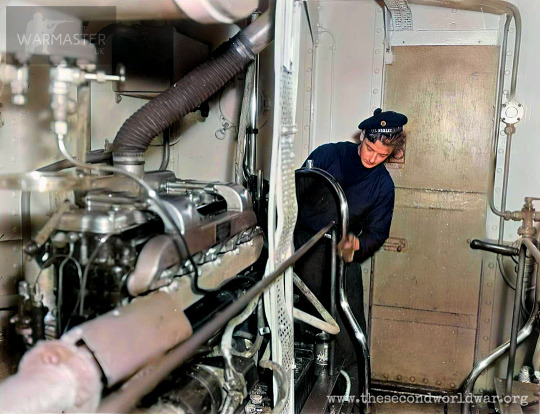
The engine room on board a Norwegian minesweeper, 1943. During the German occupation, much of the Norwegian Navy escaped to Allied territory, continuing the fight under the Norwegian government-in-exile. Operating alongside Allied forces, Norwegian ships defended convoys, engaged in anti-submarine warfare, and supported resistance efforts. Their contributions were pivotal in maintaining Norway's presence in the war against Nazi Germany.
https://nye.digitalarkivet.no/source/241506/photo/fd7d8752-dd5f-48ae-922e-f08c6b30ad93?media=photo
#secondworldwar#ww2#worldwartwo#worldwar2#war#history#militaryhistory#military#colourised#colorized#colourisedhistory#colorizedhistory#color#colour#colorizedhistoricalphotos#colorization#colourisation#retro#goodolddays#classic#goldenoldies#colorizedphoto#colourisedphoto#norway#norwegian
1 note
·
View note
Text
NATO Establishes Hub to Protect Critical Undersea Infrastructure

NATO has inaugurated a specialized center focused on the security of extensive undersea energy pipelines and cables, crucial for global communications, energy supply, and economic stability, yet vulnerable to attacks. The newly established NATO Maritime Centre for the Security of Critical Undersea Infrastructure (CUI) is based at NATO Allied Maritime Command (MARCOM) in Northwood, UK. Achieving Initial Operational Capability (IOC), the center serves as a networking and knowledge hub supporting Commander MARCOM in decision-making, force deployment, and action coordination. Royal Navy Vice Admiral Mike Utley, Commander MARCOM, stated: “Securing CUI involves more than posturing to deter future aggression; it includes robust coordination to actively monitor and counter malign or hybrid threats, denying any aggressor the cover of ‘plausible deniability.’ “Through the wide networks we are establishing in the new center, that job will become much easier to achieve. And if, in the future, nations seek NATO assistance, we will be ready to help them using our networks and data.” The center functions as the operational hub at MARCOM, while a strategic hub is located at NATO Headquarters in Brussels. This dual-hub structure aims to enhance cooperation between NATO allies, partners, and the private sector. The importance of civilian stakeholder engagement was highlighted by the Norwegian Oil Industry, which expressed its support in a joint statement along with Offshore Norge, gas transport operator Gassco AS, and energy company Equinor ASA. “It’s been a year of strong teamwork defining and establishing the center here at MARCOM, and we are now seeing the results as we reach this important milestone,” said Danish Navy Captain Niels Markussen, Director of the NATO Shipping Centre. “We’ve overcome many challenges to get here. Strong cooperation from cross-functional areas across MARCOM has been key to success, including operations, intelligence, IT, and Civil Military Cooperation (CIMIC). We’ve also worked tirelessly with other NATO entities including NATO HQ, SHAPE, SACT, and CMRE, as well as many civilian organizations.” Allies first agreed to establish a Maritime Centre for the Security of Critical Undersea Infrastructure within NATO’s Allied Maritime Command (MARCOM) at the Vilnius Summit last year, a decision reinforced by Defence Ministers in February. Read the full article
0 notes
Text
Events 6.8 (before 1950)
218 – Battle of Antioch: With the support of the Syrian legions, Elagabalus defeats the forces of emperor Macrinus. 452 – Attila leads a Hun army in the invasion of Italy, devastating the northern provinces as he heads for Rome. 793 – Vikings raid the abbey at Lindisfarne in Northumbria, commonly accepted as the beginning of Norse activity in the British Isles. 1042 – Edward the Confessor becomes King of England – the country's penultimate Anglo-Saxon king. 1191 – Richard I arrives in Acre, beginning the Third Crusade. 1663 – Portuguese Restoration War: Portuguese victory at the Battle of Ameixial ensures Portugal's independence from Spain. 1772 – Alexander Fordyce flees to France to avoid debt repayment, triggering the credit crisis of 1772 in the British Empire and the Dutch Republic. 1776 – American Revolutionary War: Continental Army attackers are driven back at the Battle of Trois-Rivières. 1783 – Laki, a volcano in Iceland, begins an eight-month eruption which kills over 9,000 people and starts a seven-year famine. 1789 – James Madison introduces twelve proposed amendments to the United States Constitution in Congress. 1794 – Maximilien Robespierre inaugurates the French Revolution's new state religion, the Cult of the Supreme Being, with large organized festivals all across France. 1856 – A group of 194 Pitcairn Islanders, descendants of the mutineers of HMS Bounty, arrives at Norfolk Island, commencing the Third Settlement of the Island. 1861 – American Civil War: Tennessee secedes from the Union. 1862 – American Civil War: A Confederate victory by forces under General Stonewall Jackson at the Battle of Cross Keys, along with the Battle of Port Republic the next day, prevents Union forces from reinforcing General George B. McClellan in his Peninsula campaign. 1867 – Coronation of Franz Joseph as King of Hungary following the Austro-Hungarian compromise (Ausgleich). 1887 – Herman Hollerith applies for US patent #395,781 for the 'Art of Compiling Statistics', which was his punched card calculator. 1906 – Theodore Roosevelt signs the Antiquities Act into law, authorizing the President to restrict the use of certain parcels of public land with historical or conservation value. 1912 – Carl Laemmle incorporates Universal Pictures. 1918 – A solar eclipse is observed at Baker City, Oregon by scientists and an artist hired by the United States Navy. 1928 – Second Northern Expedition: The National Revolutionary Army captures Beijing, whose name is changed to Beiping ("Northern Peace"). 1929 – Margaret Bondfield is appointed Minister of Labour. She is the first woman appointed to the Cabinet of the United Kingdom. 1940 – World War II: The completion of Operation Alphabet, the evacuation of Allied forces from Narvik at the end of the Norwegian Campaign. 1941 – World War II: The Allies commence the Syria–Lebanon Campaign against the possessions of Vichy France in the Levant. 1942 – World War II: The Imperial Japanese Navy submarines I-21 and I-24 shell the Australian cities of Sydney and Newcastle. 1949 – Helen Keller, Dorothy Parker, Danny Kaye, Fredric March, John Garfield, Paul Muni and Edward G. Robinson are named in an FBI report as Communist Party members. 1949 – George Orwell's Nineteen Eighty-Four is published.
0 notes
Text
Navigating the Depths: Unraveling the Growth of the Global Unmanned Underwater Vehicles Market
The global unmanned underwater vehicles (UUVs) market has experienced exponential growth, driven by technological advancements and increasing demand for maritime security and resource exploration. With a projected market valuation of US$ 24.28 billion by 2032, up from US$ 4.24 billion in 2023, this sector offers a glimpse into the future of underwater exploration and surveillance. This article delves into the factors fueling the growth of the UUV market, highlighting its diverse applications and strategic significance.
Technological Advancements: Advancements in UUV technology have paved the way for more sophisticated and versatile underwater vehicles. From Autonomous Underwater Vehicles (AUVs) to Remotely Operated Vehicles (ROVs), these unmanned systems are capable of performing a wide range of tasks, including scientific research, defense surveillance, oil and gas exploration, and underwater infrastructure maintenance. The evolution of UUVs has enabled them to undertake complex missions in depths that were previously inaccessible or hazardous for human divers, revolutionizing underwater exploration and operations.
Defense and Security Needs: In the United States, the UUV market is driven significantly by defense and security needs. The U.S. Navy, in particular, has been a major proponent of UUV technology, investing in AUVs for surveillance, mine countermeasures, and reconnaissance missions. Programs funded by the Defense Advanced Research Projects Agency (DARPA) aim to develop UUVs capable of long-duration, autonomous missions, highlighting the strategic importance of these assets in maintaining maritime superiority. The consistent increase in the U.S. Department of Defense’s budget for unmanned systems underscores the country’s commitment to advancing UUV technology for defense purposes.
Commercial Applications: Norway, with its extensive offshore oil and gas operations, represents another facet of the UUV market focused on commercial applications. The Norwegian Continental Shelf is home to one of the world’s largest offshore oil fields, where UUVs play a vital role in underwater inspections and maintenance. Companies like Equinor have leveraged ROVs for inspecting underwater pipelines, rigs, and infrastructure, reducing costs and operational risks associated with human divers. Government support for research and development in marine technologies further enhances Norway’s position as a hub for innovation in UUV applications for the oil and gas industry.
Conclusion: The global unmanned underwater vehicles market is experiencing remarkable growth, driven by technological innovation, defense and security needs, and commercial applications in industries such as oil and gas. As UUVs continue to evolve and expand their capabilities, they promise to revolutionize underwater exploration, surveillance, and resource exploitation. With strategic investments and advancements in technology, the future of the UUV market is poised for further growth and innovation, unlocking new opportunities and possibilities in the depths of the ocean.
0 notes
Text
Argentina Signs Contract to Buy Royal Norwegian Air Force P-3C Orion Maritime Patrol Aircraft
The Argentine Minister of Defense, Jorge Taiana, and the head of the Argentine Navy, Admiral Julio Guardia, oversaw the signing of a historic agreement with the Norwegian Defense Materiel Agency (NDMA). This agreement, facilitated through the National Defense Fund (FONDEF), paves the way for the acquisition of four P-3C Orion maritime patrol aircraft from Norway. These aircraft are destined to bolster Argentina's capabilities in surveillance, monitoring, and Search and Rescue (SAR) missions in the South Atlantic. The acquired fleet consists of one P-3N variant, primarily designed for SAR and Mobile Logistics Support, and three P-3C reconnaissance versions, each boasting an impressive average flight potential of 17,000 flight hours, ensuring operational service for at least 15 years. It is noteworthy that the entirety of this acquisition, including the P-3 aircraft and associated systems, will be financed through the National Defense Fund (FONDEF).
The Argentine Minister of Defense, Jorge Taiana, and the head of the Argentine Navy, Admiral Julio Guardia, oversaw the signing of a historic agreement with the Norwegian Defense Materiel Agency (NDMA). This agreement, facilitated through the National Defense Fund (FONDEF), paves the way for the acquisition of four P-3C Orion maritime patrol aircraft from Norway. These aircraft are destined to…
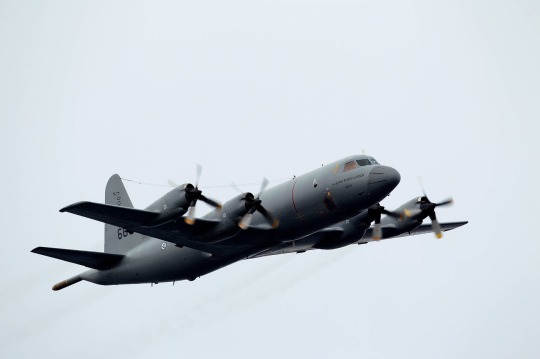
View On WordPress
0 notes
Text
Complexity call in former IGL to patch up CS:GO roster emergency for IEM Dallas

Complexity's CS:GO team had a setback before their 'home' event at IEM Dallas on May 29 due to visa complications involving their star AWPer. However, supporters shouldn't worry as a legendary in-game captain will be back for the Texas tournament. Håkon “hallzerk” Fjærli, a major component in the Complexity unit and the squad’s standout player over the past three months, was unsuccessful with his most recent visa application, as confirmed to Dust2.us via team manager Graham “messioso” Pitt. Visa issues were set to plague Hallzerk’s participation at the BLAST Paris Major American RMR in April, but an emergency exemption permitted the Norwegian sniper from attending and qualifying for his first CS:GO Major. No such exemption was allowed for this week’s Dallas tournament, however. With just a day out from their opening best-of-one against ENCE, Complexity were forced to make a late call-up to an old friend to the roster—South African legend Aran “Sonic” Groesbeek. Sonic is no stranger to the core members of Complexity; together with captain Johnny “JT” Theodosiou and coach Tiaan “T.c” Coertzen, Sonic left his home in South Africa and moved to the U.S. with Bravado in January 2018. The squad started from scratch in North America, ultimately working their way up to a LAN final against ENCE at DreamHack Winter and a victory at DreamHack Mumbai Invitational to wrap up the calendar year. Over the following years, the South African sniper, alongside JT and T.c, represented the likes of EnVyUs, Cloud9, and Extra Salt, with a smattering of event wins across 2021. Byt Sonic opted to hang up the mouse in 2022, stepping away from professional competition. He wouldn’t lose his competitive drive completely, participating in various ESEA South Africa Cash Cups throughout 2022 and 2023, before returning to the U.S. in May 2023, thus enabling him to assist with Complexity in Dallas. Complexity aren’t the only team struggling with visa issues ahead of the first tier-one tournament after the Paris Major. Virtus.pro were forced to withdraw from IEM Dallas in April, with Fnatic replacing the Russian squad. A second team—suspected to be NAVI—were also unable to attend the event, paving the way for OG to make an appearance. Complexity will be replacing NAVI at the BLAST Spring Final in Washington D.C. later in June. It is not yet clear whether Hallzerk will have his visa issue sorted by this time, with Sonic expected to remain with the roster through June. Read the full article
0 notes
Text
Royal Norwegian Navy Shv Olav Tryggvason (p380) Hawaiian Shirt Man
The Royal Norwegian Navy is a military branch of the Norwegian government. It is composed of sailors and marines who serve with great distinction in the ocean and on the land. The navy supports the Norwegian state and the Norwegian people, by providing maritime security and support. The navy operates out of the Honolulu, Hvitland, and Reykjavik ports. The marines are stationed in bases around
Get it here : Royal Norwegian Navy Shv Olav Tryggvason (p380) Hawaiian Shirt Man
Home Page : tshirtslowprice.com

1 note
·
View note
Text
Nord Stream Enigma Deepens as OSINT Analyst Finds Mystery Tanker Hung Around Explosion Site for Week

© Photo: Twitter/@OAlexanderDK
US and German media sought to turn the Nord Stream sabotage attacks into an open-and-shut whodunit detective novel this week by laying the blame at the feet of a “pro-Ukrainian group” with no links to any state. This information contradicts reporting by veteran journalist Seymour Hersh, who fingered the US and Norwegian militaries for the crime.
A Greek-flagged tanker was spotted loitering around the site of the Nord Stream attacks for six days in September 2022, two weeks before the pipelines were blown up in a sabotage attack, a Denmark-based open-source intelligence (OSINT) analyst has discovered. Trawling through data from the Automatic Identification System, a database showing the locations of ships operating across the world’s seas and oceans, analyst Oliver Alexander found that the Minerva Julie, a 183-meter-long, 32-meter-wide Greek-flagged oil and chemical tanker, stopped and then idled in an area of the Baltic Sea off the Danish island of Bornholm from September 6-13, before pressing east to Tallinn, Estonia, and then to St. Petersburg, Russia.
Alexander detailed the discovery in a Twitter thread in which he expressed skepticism about the New York Times report blaming a “pro-Ukrainian group” for sabotaging the pipelines. “Unfortunately, the new New York Times article doesn’t give any new actionable information that can be examined,” he wrote, suggesting that there wasn’t any “real substance in the article that brings us measurably closer to knowing the truth about what happened” because the entire story was based on claims by anonymous officials and intelligence sources.
Minerva Julie’s owners, Minerva Maritime, confirmed the oil tanker’s whereabouts after being reached out to by media, saying the ship was “drifting in the sea area northeast of Bornholm, Denmark between 6 September and 13 September 2022, while awaiting her next voyage instructions,” and that the tanker “departed the Port of Rotterdam on 2 September, after discharging her cargo. Once voyage orders were received, the vessel proceeded to her next port of call, Tallinn, Estonia.”
“Drifting in a sea area awaiting voyage orders is standard shipping procedure and there was nothing unusual in this instance,” the shipping company emphasized.
Alexander expressed skepticism over the company’s statement. “It just so happens to not only happen directly above the Nord Stream pipeline sabotage locations, but also at the exact same time as the currently suspected Andromeda [the rented yacht mentioned by US and German media in recent reports blaming a ‘pro-Ukrainian group’ for the sabotage, ed.] is supposedly placing explosives in the same location,” he wrote.
The OSINT analyst’s followers offered constructive criticism of his observations, with one reader pointing out that “idling at sea waiting for instructions happens very often,” and that given the fact that the pipelines are sitting on top of major shipping routes, the Minerva Julie’s position may have just been a case of “wrong place, wrong time.” Others suggested that the evidence could be a “smoking gun,” but only if it was shown that the Minerva Julie was a specialized Dive Support Vessel, because “the mission required saturation divers and…very sophisticated chambers which house them on the seafloor.”
Others took issue with the OSINT examiner’s work, saying it “makes zero sense to use a ship that can be tracked by simple OSINT,” or even accusing him of coming up with “ridiculous fake stories” to “divert attention away from” Seymour Hersh’s bombshell reporting, which fingered US Navy divers said to have rigged the pipelines to blow under the cover of a NATO military exercise last summer, with the blasts triggered by a Norwegian aircraft flying overhead on September 26. Hersh, a Pulitzer Prize-winning journalist with over 60 years of investigative journalistic experience under his belt, said his information came from a source with “direct knowledge of the operational planning.”
Last month, Sputnik received information corroborating Hersh’s reporting from a source identifying themselves as a military serviceman who took part in the NATO drills.
Senior Russian officials have largely avoided addressing The New York Times and German media reports blaming the mystery “pro-Ukrainian group” for the Nord Stream attacks, instead repeating Moscow’s demands for a thorough and transparent investigation. But former Russian President Dmitry Medvedev could not help but respond to the new claims, characterizing the Times’ report as a lackluster “Hollywood drama” featuring “mediocre actors, a director who’s no Quentin Tarantino, very poor casting and camera work, and a script that’s boring as s***.”
0 notes
Text
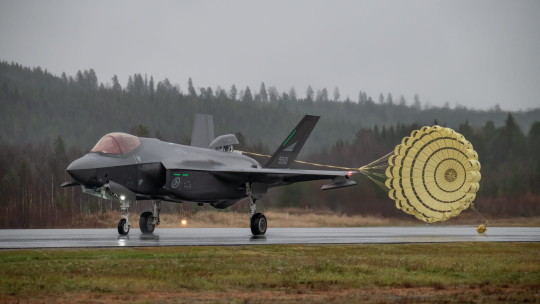
IMAGES: Norwegian F-35 fighters land in Sweden for the first time
Fernando Valduga By Fernando Valduga 10/16/2023 - 08:48am Military
On October 11, for the first time, a Norwegian F-35A Lightning II fighter landed in Sweden.

The aircraft landed at the Vidsel base in Norrbotten, as part of the cross-border training agreement between the Nordic countries.
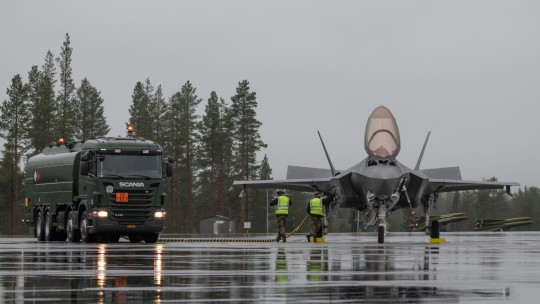
The Swedish Air Force has long experience in the concept of an air base using temporary airfields, something in which the air forces of many other nations are very interested. Norway is now developing an air base concept to be able to use air bases in other locations, when necessary in a crisis situation.

“Today's exercise shows that there is good cooperation between the Swedish and Norwegian air forces. To increase its capacity, we, as a partner country, are pleased to share with our friends our long experience in using other air bases and road bases in our Swedish concept," says the deputy head of the Air Force, Tommy Petersson.
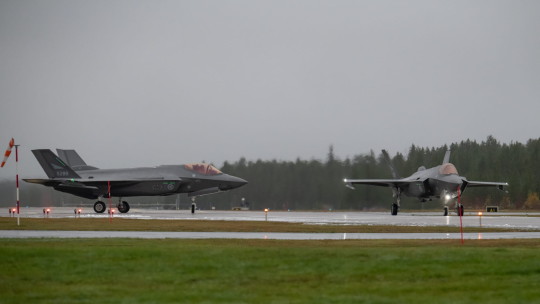
The landing at the Vidsel base took place without problems, despite the challenging weather conditions. They managed to land, prepare the aircraft and then take off and continue the exercise.

“In this way, the air operational effect is increased and our Nordic cooperation is even deeper,” says Tommy Petersson.
Tags: Military AviationF-35 Lightning IIFlygvapnet - Swedish Air ForceRNAF - Royal Norwegian Air Force / Royal Norwegian Air Force
Sharing
tweet
Fernando Valduga
Fernando Valduga
Aviation photographer and pilot since 1992, has participated in several events and air operations, such as Cruzex, AirVenture, Dayton Airshow and FIDAE. He has work published in specialized aviation magazines in Brazil and abroad. Uses Canon equipment during his photographic work in the world of aviation.
Related news
INTERCEPTIONS
Russian Su-27 fighter moves North American Global Hawk away from Russia's state border
15/10/2023 - 21:41
Lockheed Martin received a contract from the U.S. Navy to build eight MH-60R helicopters Seahawk for the Spanish Navy. In the photo, a U.S. Navy MH-60R aircraft.
HELICOPTERS
Lockheed Martin receives contract to manufacture eight MH-60R Seahawk helicopters for the Spanish Navy
15/10/2023 - 20:05
MILITARY
IMAGES: F-15E land in the Middle East to confirm USAF's "enhanced" presence in support of Israel
15/10/2023 - 11:52
INCIDENTS
Israeli CH-53 helicopter would have been shot down by Hamas rockets
15/10/2023 - 11:30
MILITARY
How Hamas paramotors managed to enter Israel's airspace
14/10/2023 - 11:00
MILITARY
France will invest 13.3 billion euros in SCAF and Rafale by 2035
13/10/2023 - 21:25
10 notes
·
View notes